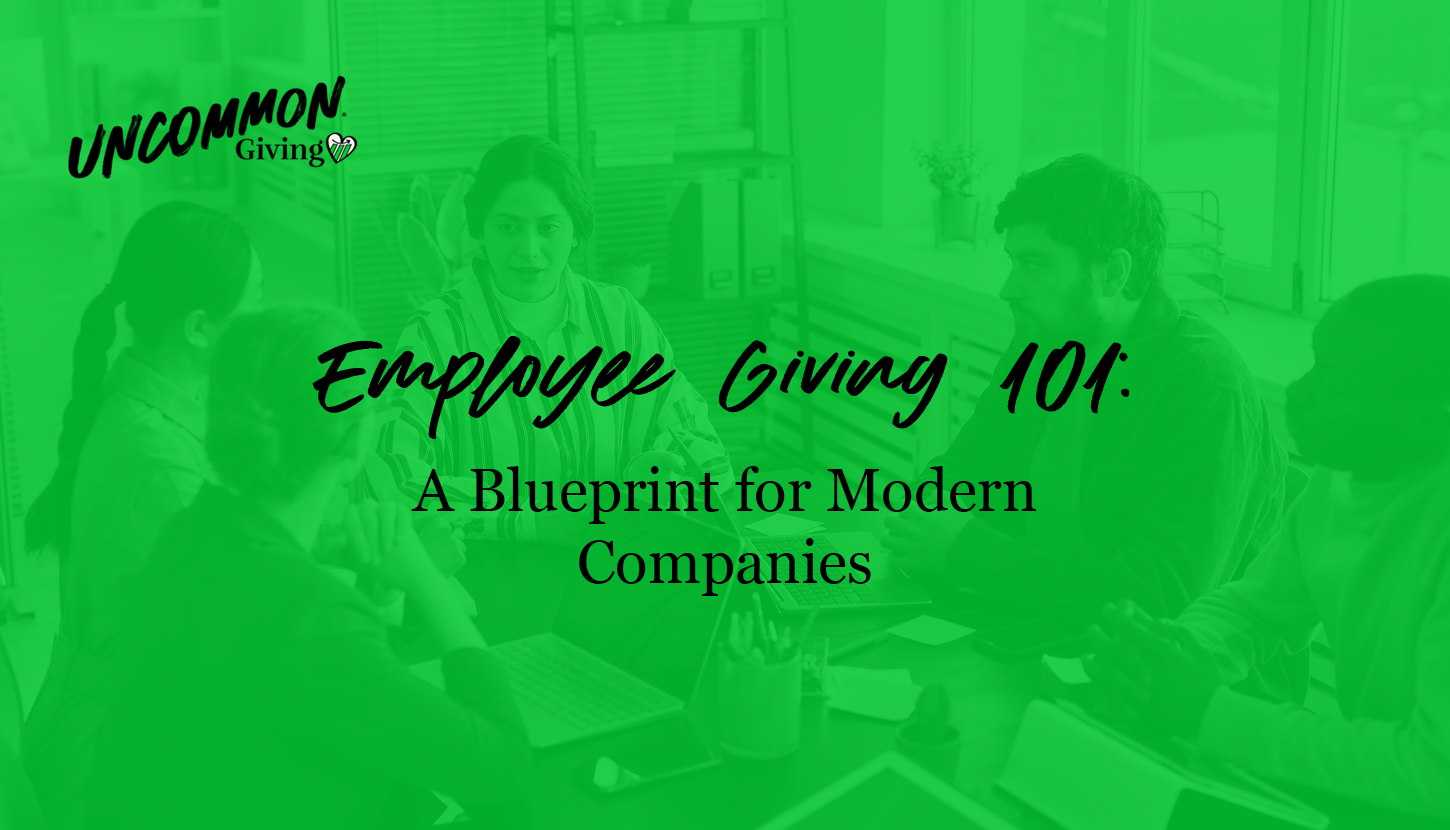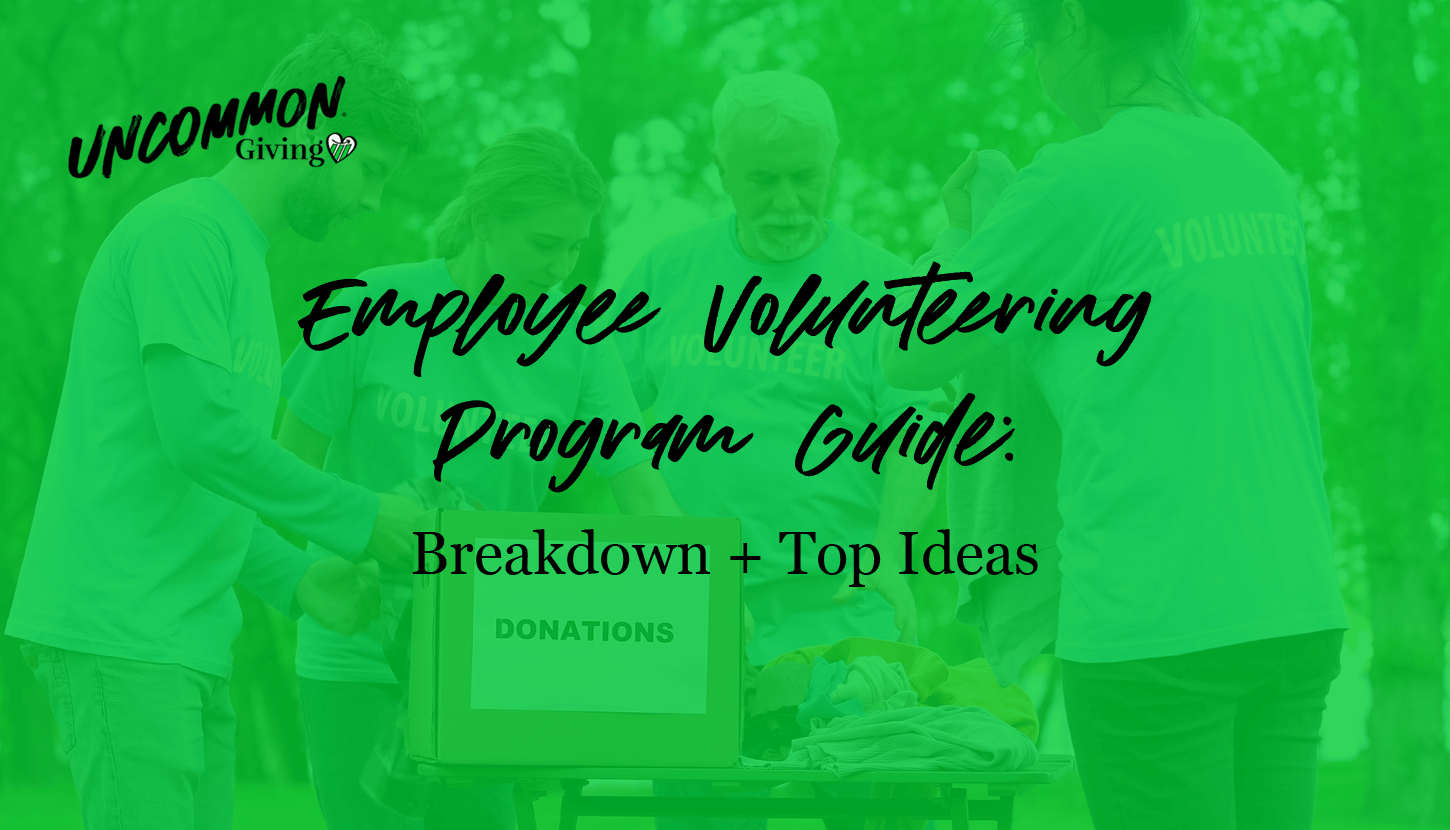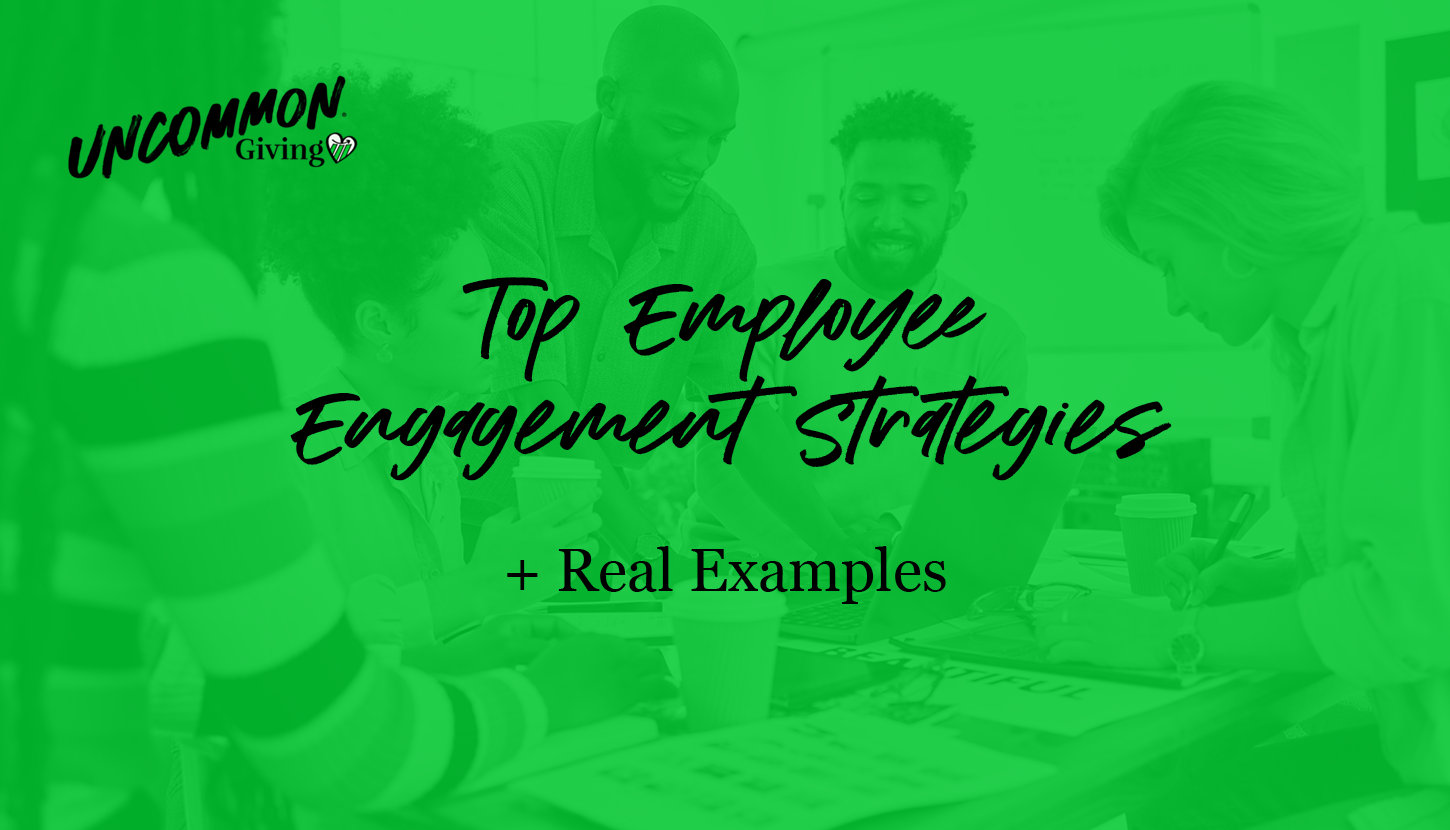The average person will spend around 90,000 hours, or one-third of their lifetime, working. That’s why, for many job seekers, a job isn’t simply a way to make money. Employees want their careers to be much more fulfilling than that, providing them with a sense of accomplishment, connection with others, and a chance to make their mark on the world. That’s where employee giving comes in.
By launching an employee giving program, your company can incorporate corporate social responsibility (CSR) into its business strategy and build a workplace that employees are proud to belong to. In this guide, we’ll cover the essentials you need to set your program up for success, including:
- Employee Giving: FAQs
- How to Start an Employee Giving Program
- 4 Strategies for Encouraging Employee Giving
- Inspiring Examples of Employee Giving Programs
You don’t have to be a Fortune 500 company to become a CSR leader in your industry. Take it one step at a time, and before long, you’ll have an entire employee base engaged with your employee giving program and eager to contribute to your social impact.

Employee Giving: FAQs
Employee giving is a broad term that encompasses many activities and strategies. To help your company set up a program that’s tailored to your specific needs and employee interests, let’s start by exploring these frequently asked questions:
What are employee giving programs?
An employee giving program is a company-sponsored initiative that encourages employees to support charitable causes through donations or volunteering. These opportunities are often part of a company’s larger workplace giving strategy, which may involve providing grants to nonprofits.
Alongside employee and workplace giving, your company might take other steps toward improving its impact on the world. For example, you could reduce your carbon footprint by entering employees who carpool in monthly drawings to win rewards such as gift cards or free meals.
What are the benefits of employee giving?
Implementing an employee giving program can yield benefits across nearly every aspect of your business. Notably, employee giving can help you:
- Attract younger generations of talent. According to Deloitte, 75% of Gen Zers and millennials indicate that community engagement and societal impact are important factors when considering potential employers.
- Appeal to socially conscious customers. Many of today’s customers are looking for more than just quality products and services when choosing their brands. In fact, 77% of consumers want to purchase from companies with CSR initiatives.
- Engage and retain more employees. By making it easy for employees to give back to their communities, you can provide them with a stronger sense of fulfillment and purpose in their roles.
- Improve your brand reputation. PwC found that, while 87% of executives believe customers highly trust their companies, only 30% actually do. Establishing an employee giving program demonstrates to consumers, employees, and investors that your company is committed to ethical behavior and making the world a better place.
The bottom line: A well-managed CSR program can increase your company’s revenue by up to 20% and employee productivity by 13%, powering your long-term growth and success.

What are the main types of employee giving?
Your employee giving program can include a range of activities for employees to engage in. The most common ones are:
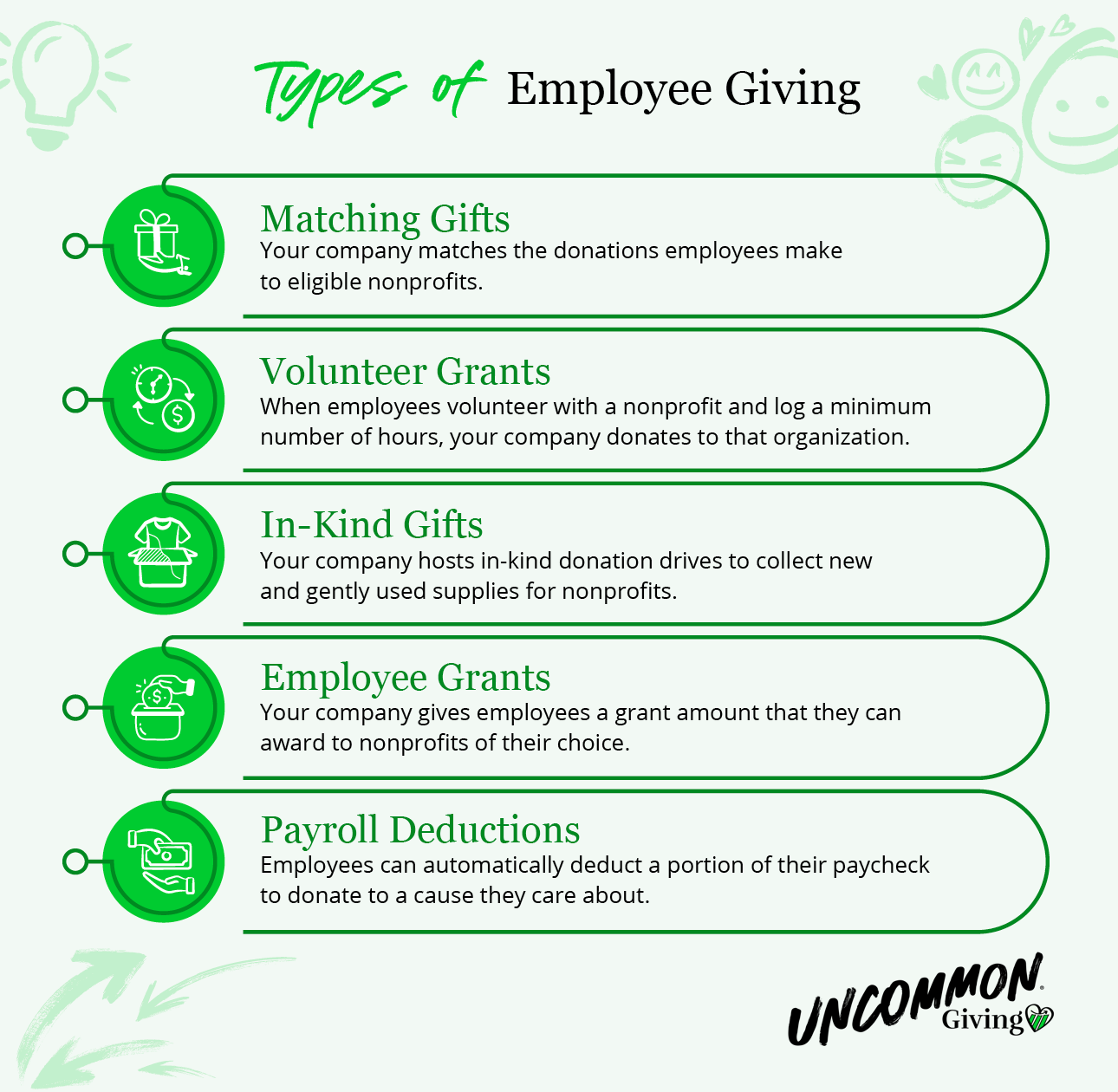
- Matching gifts. Your company will match the donations your employees make to eligible nonprofits, usually at a 1:1 ratio. Through matching gifts, employees can double or even triple the impact of their charitable contributions, all without having to spend another dollar.
- Volunteer grants. When your employees volunteer regularly with a nonprofit and log a minimum number of hours, your company will donate to that organization. The amount you give will typically depend on the hours your employees contribute—for example, $300 for every 20 hours volunteered.
- In-kind gifts. Your company can host in-kind donation drives to collect essential supplies for nonprofits in your area. For instance, you might encourage employees to donate gently used books, notebooks, and e-readers to an organization working to improve literacy within your community.
- Employee grants. Allow employees to take the lead in supporting causes close to their hearts by giving them an annual grant amount they can award to an eligible nonprofit. You can either provide this opportunity to all employees or use it to reward stellar performance in the workplace.
- Payroll deductions. Employees can set up payroll deductions to automatically withdraw a portion of their paycheck to donate to a nonprofit of their choice. This option makes it more convenient for employees to become regular contributors to charitable organizations.
While these types of employee giving are popular among companies of all sizes, don’t be afraid to get creative with opportunities that align with your employees’ interests and preferences. Patagonia, for example, has an Environmental Internship Program through which employees can spend up to two months working at an environmental group of their choice while receiving their regular pay.
How to Start an Employee Giving Program
To create a thriving and sustainable employee giving program, you need a strong foundation. Follow these steps to build a program that’s tailored to your goals and needs:
Set a budget and guidelines.
First, establish where employee giving fits into your company’s larger business strategy and employee engagement plans. Meet with your leadership team and board members to decide how much funding you’ll allocate for an employee giving budget. Secure their buy-in upfront by emphasizing the benefits of launching one of these programs and highlighting how it will enhance your company culture.
Then, establish your program guidelines. Create an official employee giving policy that outlines key details such as:
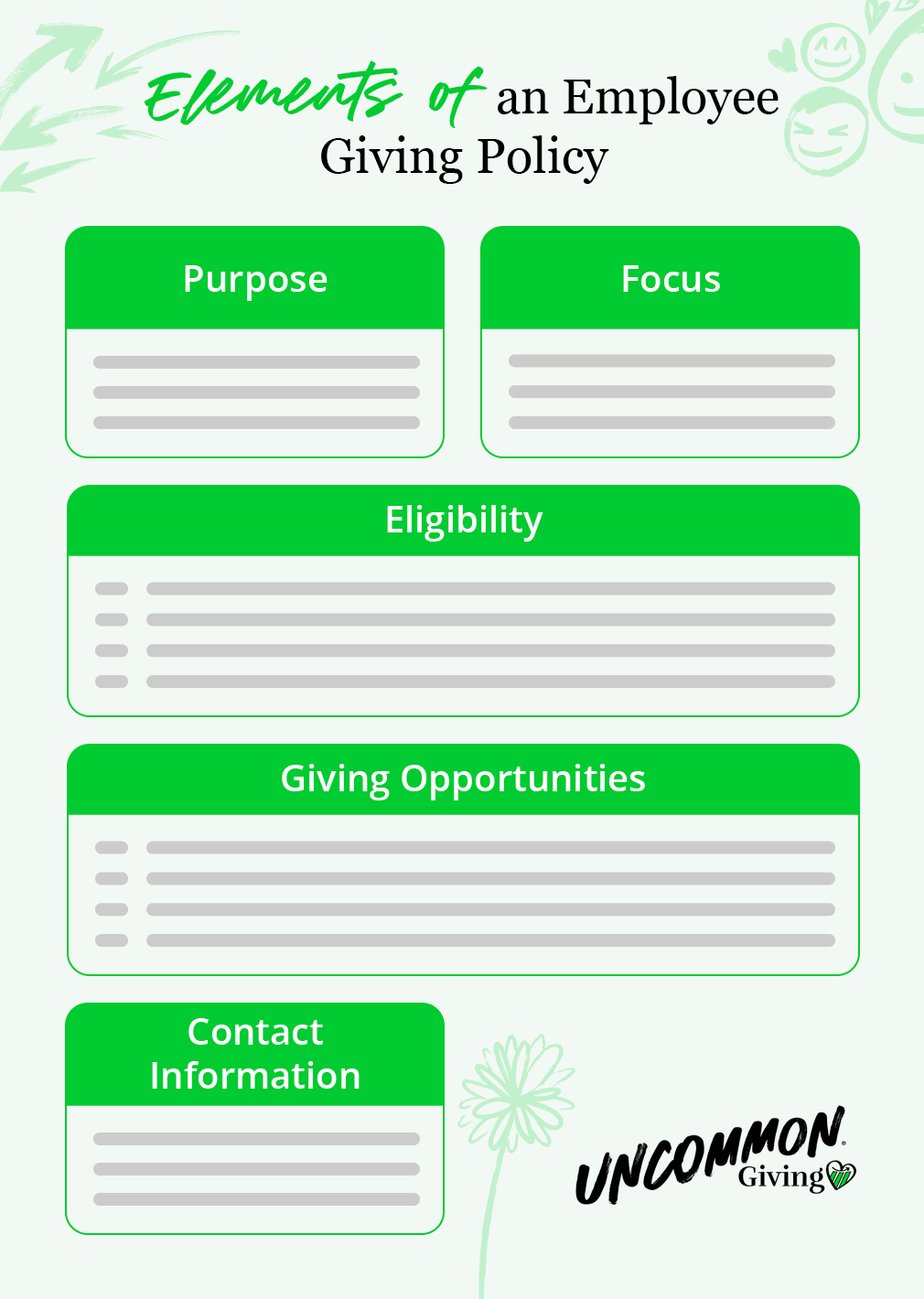
- Purpose. Explain what your company aims to accomplish with its employee giving program, and tie it back to your mission and values. Establishing this connection early on ensures that employees understand why the program is important to your company’s overall success and how they can play a role in it.
- Focus. Some companies focus their employee giving program on specific types of nonprofits or charitable causes. For example, a pharmaceutical company might primarily support organizations that conduct health research or provide mental health resources to the community. If you want to narrow your program’s focus on causes related to your mission, highlight them in your employee giving policy.
- Eligibility. Specify which organizations are eligible for support. Many U.S. companies only contribute to nonprofits with official 501(c)(3) status. Additionally, clarify whether full-time, part-time, and retired employees can participate in your program. Some companies even match gifts made by employees and their spouses.
- Types of Giving. List the giving opportunities your employee giving program entails, along with relevant details. For example, if you’re offering matching donations, include information such as your match ratio, minimum and maximum match amounts, and match request deadline in this section.
- Contact Information. Your employees may have more specific questions about participating in your program. To make it easy for them to get involved, include the email or phone number of a designated contact who can share more information as needed.
Later on, as your program expands, consider building out separate documents on matching gifts and your other employee giving opportunities to provide more in-depth guidance for participation.
Invest in employee giving tools.
Many companies hesitate to introduce employee giving opportunities because they’re concerned about having insufficient resources to manage them properly. However, the emergence of modern, lightweight workplace giving software has eliminated this concern. By adopting one of these platforms, companies of all sizes can manage employee giving programs with minimal effort.
When researching potential solutions for your business, look for these essential features:
- Corporate giving. Make donations and grants to nonprofits using an automated, equitable giving strategy.
- Employee giving. Facilitate matching gifts, volunteer grants, and payroll deductions for employees. Automatically approve requests based on preset criteria.
- Volunteer management. Promote local volunteering opportunities, plan team-wide events, and allow employees to log their volunteer hours.
- Auto-submission. The most innovative workplace giving platforms offer matching gift auto-submission, which makes the matching gift process faster and easier than ever. Employees can automatically complete and submit their match requests by simply inputting their company email addresses when donating.
- Reporting. Use real-time reporting dashboards to measure your impact and report it to stakeholders.
Explore online reviews and reach out to peers at similar companies for recommendations. When you’ve created a short list of potential platforms, request demos to see firsthand how they can support your employee giving program. Consider the user-friendliness of the software, along with the customer support available, before you make your final decision.
Launch your employee giving program.
Once you’ve laid the groundwork for your employee giving program, it’s time to set it in motion. To maximize employee participation, you need to spread the word and make them aware of these involvement opportunities. According to Double the Donation, only 19% of companies include more than one paragraph about matching gifts in easily accessible employee-facing materials.
Build excitement from the start by:
- Producing an attention-grabbing announcement video.
- Incorporating your employee giving policy into your onboarding materials and employee handbook.
- Hosting a company-wide Q&A session to discuss program details.
- Providing program overviews in your company-wide newsletter and website.
- Sharing program updates and accomplishments on social media.
During the early stages of your program, identify your most passionate participants, or those who actively engage with your opportunities. Enlist them to promote your employee giving programs to their colleagues by inviting them to lead volunteer events or set up donation drives. Encourage them to share their personal experiences and stories on social media to inspire others to get involved.
Assess your program’s performance.
You know that employee giving can transform your company’s culture and community relationships for the better. But how do you know that you’re getting the results you set out to achieve?
By tracking your results and making ongoing improvements, you can refine your employee giving program over time and enhance your social impact.
The following metrics can clue you in on your program’s performance:
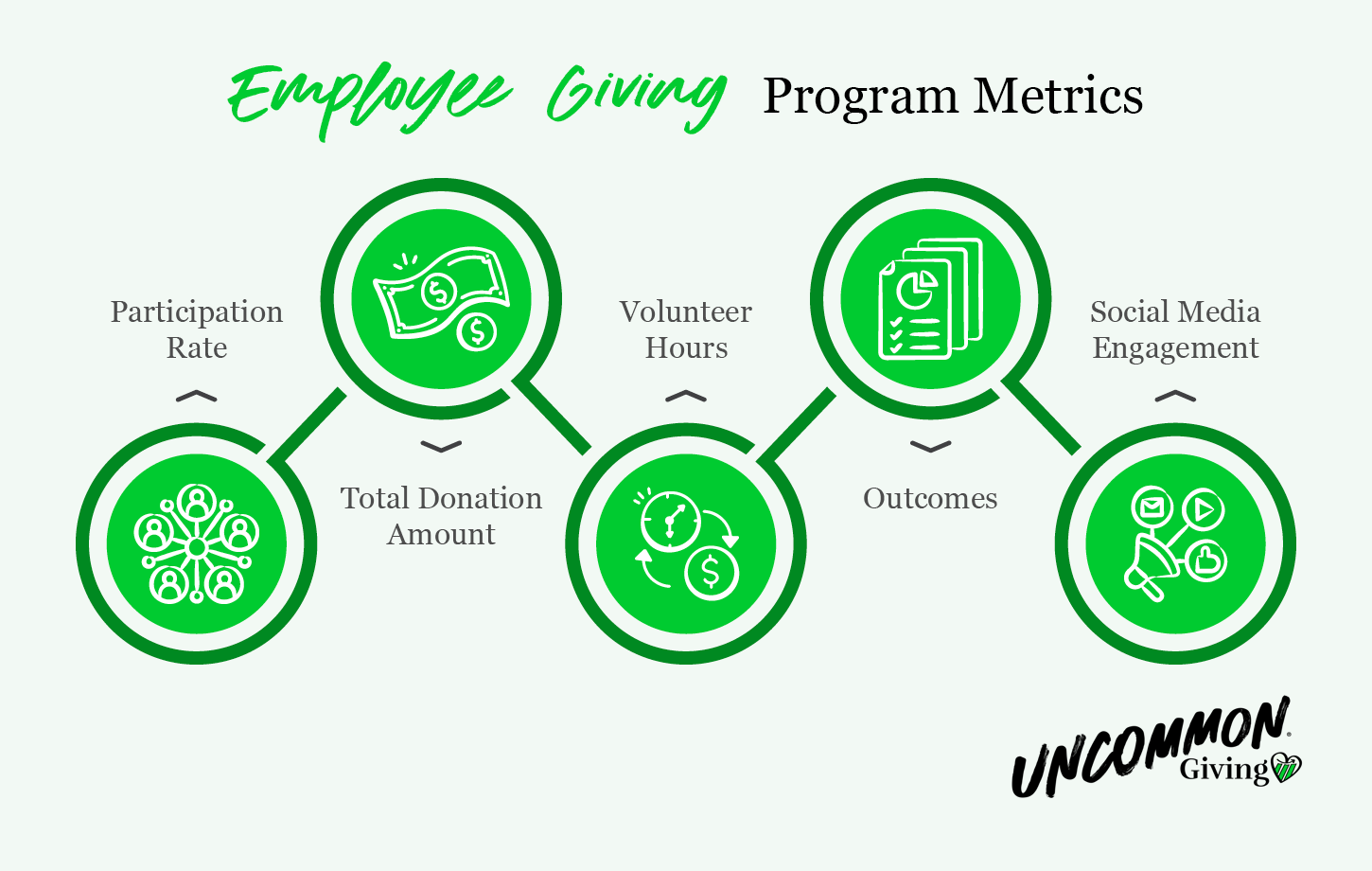
- Participation rate. Out of your total number of employees, how many people engage with your program? A lower participation rate might indicate that you need to promote your program more or add more incentives for getting involved.
- Total donation amount. Keep track of the total amount of money your program has contributed, including both individual employee donations and company matches. To increase this number, consider adjusting your program guidelines, such as increasing your matching gift ratio to 2:1 or even 3:1 to entice more employees to participate.
- Volunteer hours. Monitor the total number of hours your employees volunteer through your program to determine how well you’re inspiring them to get involved in their community. To encourage more participation, partner with local nonprofits and use your employee volunteering tools to coordinate dedicated events for your teams.
- Outcomes. Ask your nonprofit partners to report the impact of your donated funds or employee volunteer contributions. For example, an environmental conservation organization might share that, thanks to your employee and company-matched donations, it was able to plant 7,000 trees in the past year.
- Social media engagement. Note the number of likes, shares, and comments your employee giving-related posts receive on social media. These metrics can reveal how your employees, customers, and community members perceive your program and its impact.
Use these data points to identify your program’s strengths and areas for improvement. Maintain transparency by communicating this information to your employees and other stakeholders, too. Many companies publish annual CSR reports to consolidate their accomplishments and impact into one easy-to-read document.

4 Strategies for Encouraging Employee Giving
You may have established a well-thought-out employee giving program, but you need to infuse it into your company culture if you want it to stick. Explore these four strategies to make employee giving a central part of your operations and activities:
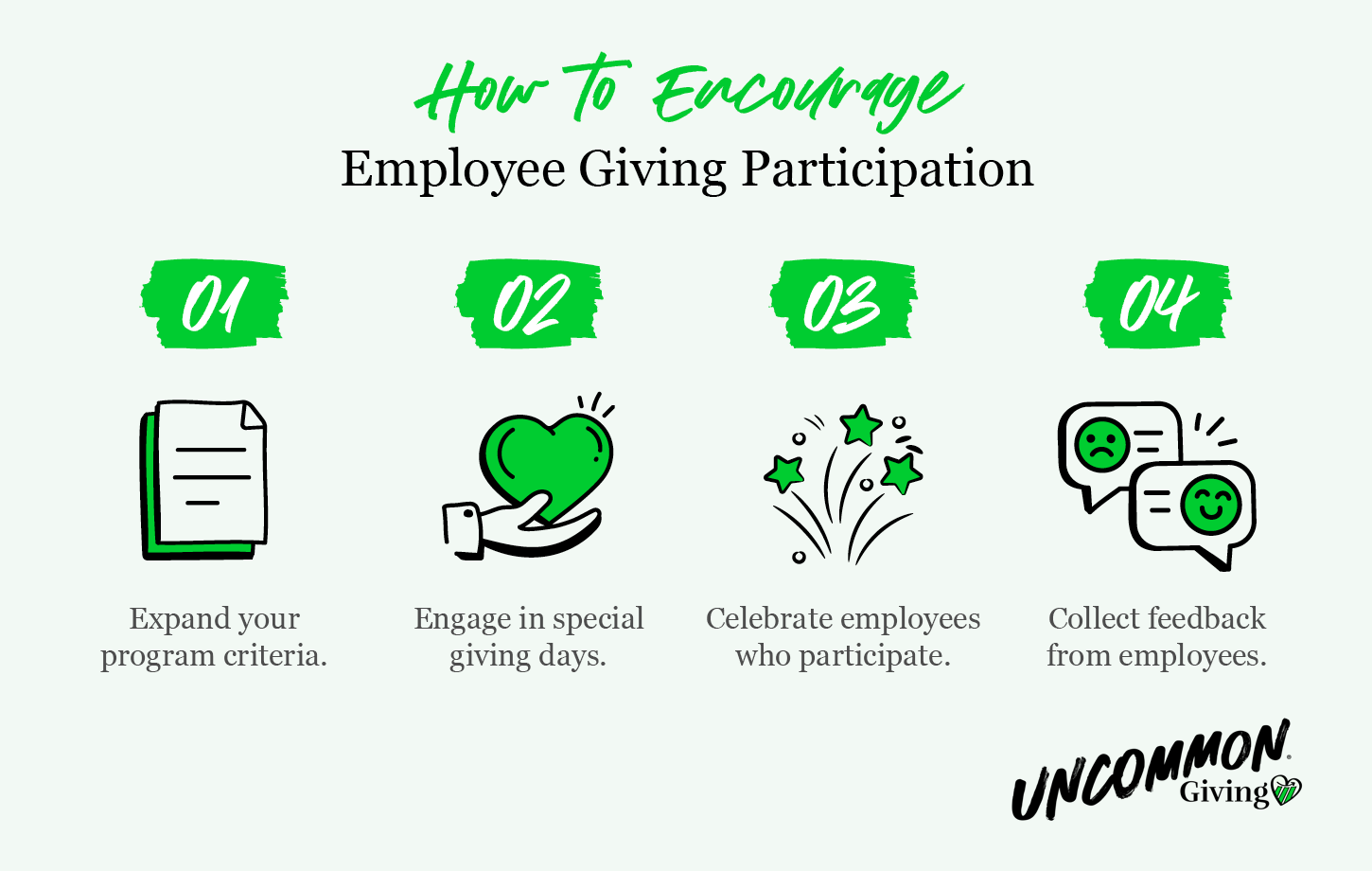
Expand your program criteria.
There are some easy adjustments you can make if you notice that employee participation rates aren’t as high as you want them to be. Start by identifying ways to make participation as flexible and convenient as possible. For example, you could:
- Extend program eligibility to part-time employees, retired employees, and even employees’ spouses.
- Lower your minimum match amount so that employees can give at levels they’re more comfortable with.
- Increase your maximum match amount to encourage more generosity among employees.
- Adjusting your volunteer grant offerings, such as awarding $15 per hour volunteered rather than $750 for every 50 hours volunteered.
- Allow employees to support any 501(c)(3) organization, rather than nonprofits that fall under a specific cause or focus area.
- Provide volunteer time off (VTO), so employees can find time to volunteer with nonprofits during normal working hours.
97% of donors want flexibility in where and how they give to causes they care about, such as having their employer match gifts to any nonprofit of their choice. By allowing employees to get involved in their preferred ways, you ensure that they have every reason to keep participating in your program.
Engage in special giving days.
Your employees lead busy lives. Sometimes, giving back to their community can fall off their radars. To reignite their generosity and rally them behind your CSR efforts, look out for special cause awareness and giving days your company can participate in. There are plenty of opportunities to consider depending on employee interests and your overall mission, such as:
- World Day of Social Justice in February
- Earth Day in April
- International Youth Day in August
- International Literacy Day in September
- World Mental Health Day in October
- World Diabetes Day in November
Giving Tuesday, which occurs on the Tuesday after Thanksgiving in the U.S. every year, is one of the most popular giving days for companies to participate in. On this day, you can host a staff-wide volunteer event, organize an in-kind donation drive, or offer to match gifts at a higher ratio to motivate employees to get involved.
Celebrate employees who participate.
According to research conducted by Gallup and Workhuman, employees who say their recognition program is aligned with their company’s values are 4.9 times more likely to strongly agree that they know what is expected of them at work.
Strengthen your workplace culture, boost morale, and inspire employee giving engagement by recognizing those who participate in your program. Some of the top methods include:
- Sending thank-you emails and eCards to employees who attend a company volunteering event.
- Presenting recognition awards, such as “Social Impact Star” or “Ambitious Advocate,” to top employee contributors to your program.
- Highlighting employee giving participation in company-wide newsletters, social media pages, and website blog articles.
- Hosting an annual event to celebrate the impact your employees have accomplished together.
Incorporate a mixture of group recognition and individual recognition to reinforce participation across your employee base. Personalize your messages when possible to demonstrate that you value your specific contributions to your program.
Collect feedback from employees.
To maintain ongoing participation in your employee giving program, you need to fine-tune it according to employees’ needs, preferences, and interests. Create opportunities that they’ll never grow tired of by sending a survey once or twice a year to collect their feedback. Consider asking questions such as:
- What would motivate you to participate more in our employee giving opportunities?
- What obstacles, if any, have kept you from getting involved?
- What types of giving or volunteering opportunities are you most interested in?
- What specific causes would you like our program to support more?
- How do you prefer to learn about the impact our employees have generated through the program?
- What improvements, if any, would you like to see in our program?
While it may not be feasible to apply every piece of feedback to your employee giving program, use these survey responses to identify common concerns or opportunities you should address. For example, if you notice that many of your employees are passionate about tackling food insecurity in their community, you could reach out to local hunger relief nonprofits to establish more formal partnerships or volunteering opportunities.
Inspiring Examples of Employee Giving Programs
Every company has its own approach to employee giving. When building or improving your employee giving initiatives, it can help to look at other examples of established programs for inspiration. Here are a few top examples to get you started:
Bombas
Bombas is an apparel company that donates an item of clothing for every customer’s purchase. Beyond these product donations, Bombas engages its employees in various social impact opportunities. For example, Bombas:
- Hosted a community dinner on Giving Tuesday, gathering individuals experiencing homelessness and business peers for a family-style meal.
- Allows employees to choose an organization every year and allocates up to 2,000 pairs of donation socks to give to that organization.
- Engages employees in helping shelters host monthly pizza nights.
It’s clear that Bombas understands the importance of giving employees the freedom to support the causes that are closest to their hearts through employee giving. Uncommon Giving’s corporate giving software provides a database of over 1.5 million vetted nonprofits that employees can browse at their convenience to direct their donations and volunteer time.
BlastX Consulting
BlastX Consulting is a digital customer experience consulting agency with employees who are committed to making their mark in their communities. Some of the charities the company has supported through donations include:
- NAACP
- The Trevor Project
- St. Jude Children’s Research Hospital
- Girls Who Code
- Make-A-Wish Foundation
Plus, BlastX has a peer-to-peer recognition program that allows team members to send kudos to one another—these can be exchanged for gift cards or donated to a nonprofit.
Ironwood Pharmaceuticals
Ironwood Pharmaceuticals is a biopharmaceutical company that embraces a culture of giving and volunteerism across its employee base. A few ways this company engages in community giving include:
- Annual employee-led charitable initiatives
- Monthly employee volunteering opportunities
- Operation GIving, an all-company day of service
Plus, Ironwood provides medical education grants that support initiatives to improve the quality of healthcare and independent education. Employees, customers, and other stakeholders can explore more about the company’s impact in its Environmental, Social and Governance Report, which goes into detail about its approach to corporate responsibility.
Wrapping Up: Making a Difference Through Employee Giving
Think of your employee giving program as a journey. Your company has the potential to touch hundreds or even thousands of lives through the philanthropic opportunities you facilitate for your employees.
No matter where you are in your journey, Uncommon Giving’s workplace giving tools are here to help. By patiently monitoring your results and improving your strategies, you can establish your business as a force for social change in the eyes of employees, customers, and other stakeholders in your community.
For more information on how to improve employee giving and engagement at your company, check out these additional resources:
- What Is Workplace Giving? 5 Steps to Boost Engagement. Learn the fundamentals of successful workplace giving programs in this comprehensive guide.
- 11 Best Corporate Giving Software for Easy Social Impact. Jump-start your research by exploring the top corporate giving platforms and how companies are using them to navigate recent trends in philanthropy.
- 12 Top Corporate Volunteering Platforms for Making an Impact. Get a rundown of some of the most innovative corporate volunteering tools on the market, including the top features you need to engage employees.
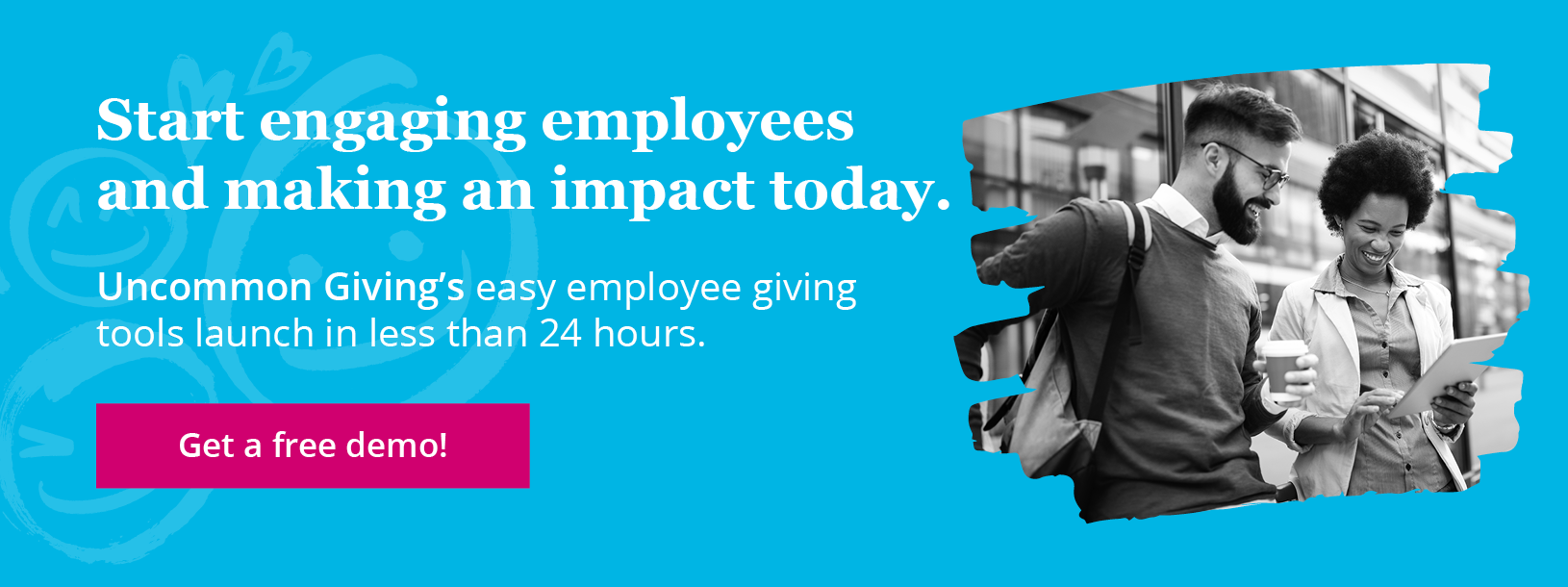
Andy Howell
Andy Howell is the CEO of Uncommon Giving, a Charleston-based social impact platform that helps companies engage employees in workplace giving and volunteering—think of it as “generosity-powered” employee engagement. Uncommon Giving provides modern, cost-effective tools for employers to live their corporate values, improve employee morale, and enhance brand reputation.Andy has spent the majority of his career working with SaaS companies serving the nonprofit, HR, and social impact spaces, including Blackbaud, Benevity, Benefitfocus, and Bloomerang. In his role today, he brings a distinct point of view to the meaningful connection between corporate social responsibility, employee engagement, and the desire to make the world a better place.

